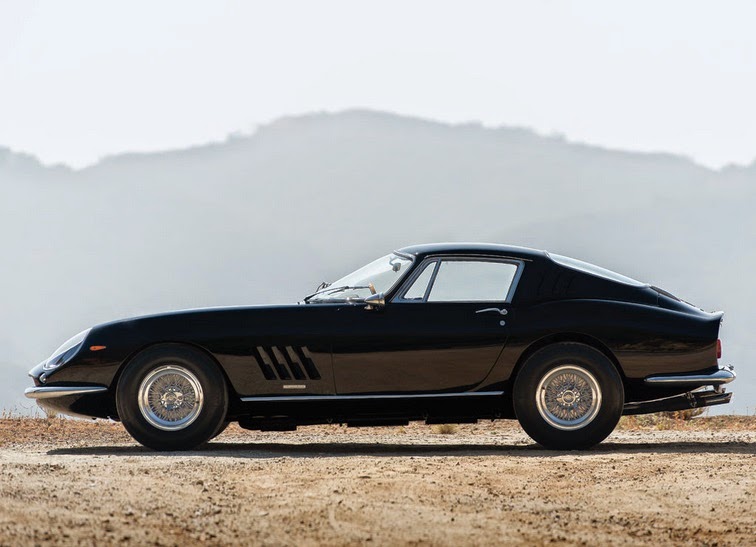 |
| Ferrari 275 GTB/4 by Scaglietti 1967 |
In late 1966, Ferrari used the Paris Motor Show to debut the latest development of its 275 GTB, the V-12 berlinetta that had been introduced to replace the long-running 250 series just two years earlier. With the addition of a second overhead camshaft to each cylinder bank, Ferrari squeezed one final iteration out of the venerable 60-degree, short-block Colombo motor that had powered the 250 and early 275 models, and in the process, they created the first dual overhead-cam engine ever used in a Ferrari road car. The engine was equipped standard with six Weber carburetors, which were previously just an option on the single-cam powerplant, and this new engine configuration distinguished itself by developing an additional 20 horsepower.
 |
| Ferrari 275 GTB/4 by Scaglietti 1967 |
The newly christened 275 GTB/4, aptly named for its four-cam-valve actuation, did not visually compromise any aspects of the prior 275 GTB’s beautiful Pininfarina body design, even with the addition of a sporty raised hood bulge to accommodate the additional hardware. The 275 GTB/4 is deemed by many Ferrari collectors to be the best looking and performing variant of the late 1960s V-12 berlinetta, and it was produced in a sparing quantity of approximately just 330 examples. The model’s rarity, ever-rewarding performance characteristics, and classic good looks have made it one of the most celebrated grand touring Ferraris of all time.
 |
| Ferrari 275 GTB/4 by Scaglietti 1967 |
The stunning “four cam” offered here is documented by Ferrari historian Marcel Massini, who notes that factory records state the car as having been delivered in Nero (20-B-50) with matching Nero (VM 8500) Connolly leather interior. As the current owner recounts, the factory further records this as one of only two 275 GTB/4s finished in this menacing, impressive color scheme. The factory completed the car in June 1967, and the following month, it was delivered to its original owner through Motor S.a.s., the official Roman dealer.
Today, the 275 GTB/4 is loved by a who’s who of Ferrari-admiring entertainers. That was also true in period, as the original owner of this car was “Little Tony,” the award-winning and incredibly popular Italian vocalist of the 1960s. Drawing inspiration from Little Richard and Elvis Presley, his recordings regularly sold in excess of a million copies in their home market, and he performed to sold-out crowds worldwide for 40 years. He was an enthusiast of Maranello’s finest automobiles and used this 275 GTB/4 to replace a 250 GT Cabriolet. Little Tony, born Antonio Ciaccia, was a resident since birth of San Marino, and he registered the Ferrari there as RSM 4597.
 |
| Ferrari 275 GTB/4 by Scaglietti 1967 |
On January 9, 1968, the car passed to its second Italian owner, Erminio Merlo, of Milan, where it was registered as MI E 96317 and continued to be serviced in Modena. Merlo passed the car later in 1968 to the Società Manutenzione Industriale Generali M.I.G. S.r.l., of Livorno, presumably for one of its directors. The car was re-registered on Livorno plates LI 113481, and it remained in the Società’s care until March 1971, when the registration was canceled due to the 275 GTB’s export to the United States.
The Berlinetta’s first known American owner was Jake Weaver, who took possession of the car in 1979. It had been repainted red by that time, but it still showed only 17,000 miles. Weaver sold the car in 1981 to well-known Ferrari collector and enthusiast Neal Shevin, of Evanston, Illinois. Mr. Shevin was the 275 GTB/4’s longest-term owner, as he cared for it for a remarkable 26 years. In 2007, chassis number 10063 was then acquired by Alex Bize, a prominent businessman, in continuation of its tradition of prominent caretakers.
 |
| Ferrari 275 GTB/4 by Scaglietti 1967 |
The car was most recently acquired by a well-known Southern California Ferrari dealer, who intended to drive it every day, as he does his 250 GT Cabriolet. Upon learning that it was one of only two four-cams finished in black, he decided to refinish the car in its original colors. As restoration progressed, it was realized that the rest of the car, including its engine compartment and suspension, would be overshadowed by the new show-quality paint, interior, and chrome. As a result, it was decided to restore those elements to “factory new” status as well.

Niciun comentariu:
Trimiteți un comentariu